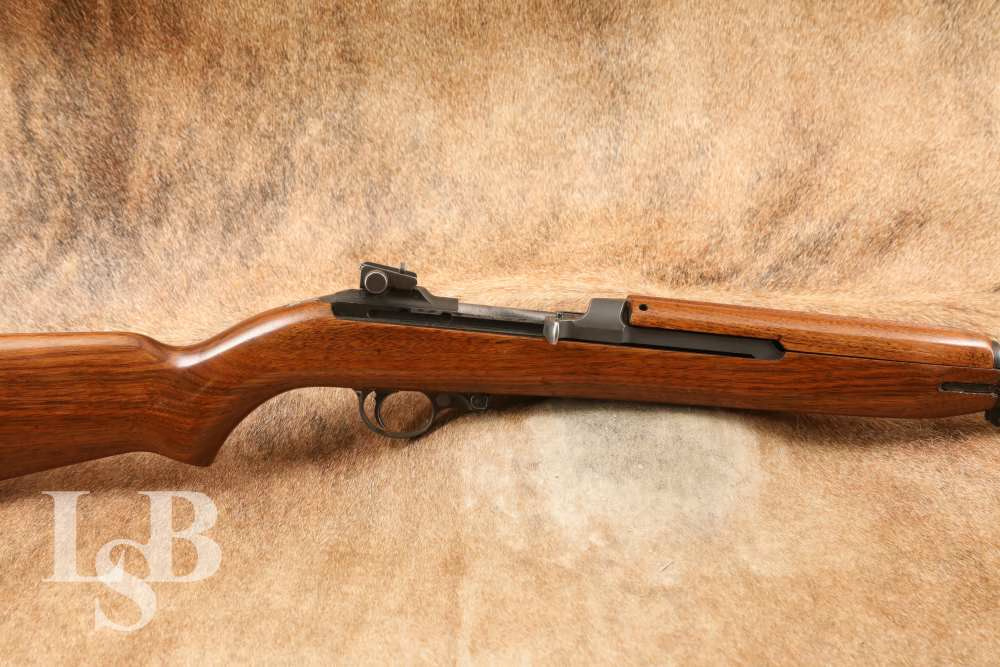
WWII Inland Division General Motors M1 Carbine .30 Cal Semi Auto 1944 C&R
SOLD FOR: $1,275.00
LSB#: LSB250512SG097
Make: Inland Division of General Motors
Model: M1 Carbine
Serial Number: 6635792
Year of Manufacture: Late 1944, Barrel Date 12-1944.
Caliber: .30 Cal Carbine
Action Type: Semi-Automatic carbine fed by detachable magazines.
Markings:
The top of the receiver is marked, “U.S. CARBINE CAL. 30 M1 / INLAND DIV. 6635792”. The bottom is marked “G”.
The magazine release is marked “M” and “EI” for Eaton Pond Co. correct for Inland
The rear sight is marked “I.R.C.O.”-for International Register CO.
The Lug is unmarked
The stock is marked “IO” for Inland Overton. The right side of the stock has a large ordnance wheel.
The upper handguard is marked “LW-B” for Lumb Woodworking Co.
The trigger group is marked “INLAND”
The hammer is marked “HI” for Hillerich Machine Company.
The cross bolt safety is unmarked
The slide is marked “7160091” and “PI” on the inside. For Packard Inland.
The Bottom of the barrel has no markings, The barrel flat has the usual Inland “hieroglyphics”, The top of the barrel is marked “P” about 2.75 inches back from the front sight, the end of the barrel is marked “INLAND MFG. DIV. GENERAL MOTORS 12-44”.
The front sight is stamped with an “N”
The barrel band is marked “KI” for Keeler Brass Co.
Barrel Length: 18″
Sights / Optics: The front sight is a fixed blade set between protective ears. The rear sight is the later style sliding aperture sight with a knurled windage knob dovetailed to the receiver.
Stock Configuration & Condition: The stock is an Oval cut, low wood stock, with a two rivet handguard, type three barrel band with bayonet lug, a crossbolt safety and a checkered metal buttplate. The LOP measures about 13.25” from the front of the trigger to the back of the buttplate. The wood has been sanded and refinished with a gloss finish. The wood shows scattered minor compressions and some surface level lines. There are some small chips from the nose of the handguard, and around the edges of the sling cut. There are no visible cracks. The buttplate has lost most of its finish and shows surface rust. The checkering is sharp. Overall the stock set is in Good+ condition.
Magazine Quantity & Condition: None.
Type of Finish: Parkerized / Blued
Finish Originality: Original
Bore Condition: The bore is bright with visible rifling. There is no visible erosion or pitting. In this writer’s opinion the bore rates 9/10.
Overall Condition: The rifle retains 90% of its metal finish. The finish has thinned from age and cleaning. The bolt and action show finish loss on the friction surfaces. The markings are mostly clear and the screw heads are sharp with a few minor tool marked slots. Some of the edges show a thinned finish with some very minor surface level lines. Overall this rifle is in Good+ to Very Good condition.
Mechanics: The action functions correctly. We did not fire this rifle. As with all used firearms, a thorough cleaning may be necessary to meet your maintenance requirements.
Box, Paperwork & Accessories: None.
Our Assessment: During the early stages of World War II, the U.S. military recognized the need for a lightweight rifle that would bridge the gap between the heavy and cumbersome M1 Garand rifle and the standard issue sidearm, the M1911 pistol. The goal was to provide troops with a compact and easy-to-handle firearm that offered more firepower than a pistol but was lighter and more maneuverable than a full-size rifle. In 1941, the U.S. Army’s Ordnance Department contracted with various manufacturers, including Winchester and General Motors’ Inland Division, to develop and produce the M1 Carbine. The rifle was designed by a team led by firearms designer David Williams, who drew inspiration from the successful M1 Garand and the short-recoil action of the M1 Thompson submachine gun. The M1 Carbine featured a gas-operated, semi-automatic action and fired a .30 caliber cartridge known as the .30 Carbine. The cartridge, while less powerful than the standard .30-06 ammunition used in the M1 Garand, offered greater capacity and reduced recoil, making it more controllable and well-suited for short to medium-range engagements. The M1 Carbine saw widespread use in World War II, becoming a staple firearm for American troops. It was praised for its reliability, ease of use, and versatility. The rifle was not only issued to U.S. forces but also provided to allied nations through various lend-lease programs. After World War II, the M1 Carbine continued to serve in the Korean War and saw limited use in subsequent conflicts. It also became popular among civilian shooters and collectors due to its historical significance and manageable recoil. Overall, the M1 Carbine played a significant role in U.S. military history, offering a lightweight and reliable firearm that filled a niche between pistols and full-size rifles. Its compact design, firepower, and ease of use made it a favored weapon among soldiers in various roles and contributed to its enduring legacy. To better understand this M1 carbine please see our high quality photos via the link and best of luck with your bidding!!!-R.L.

